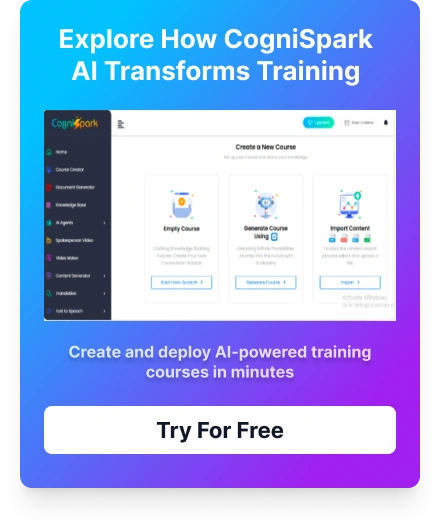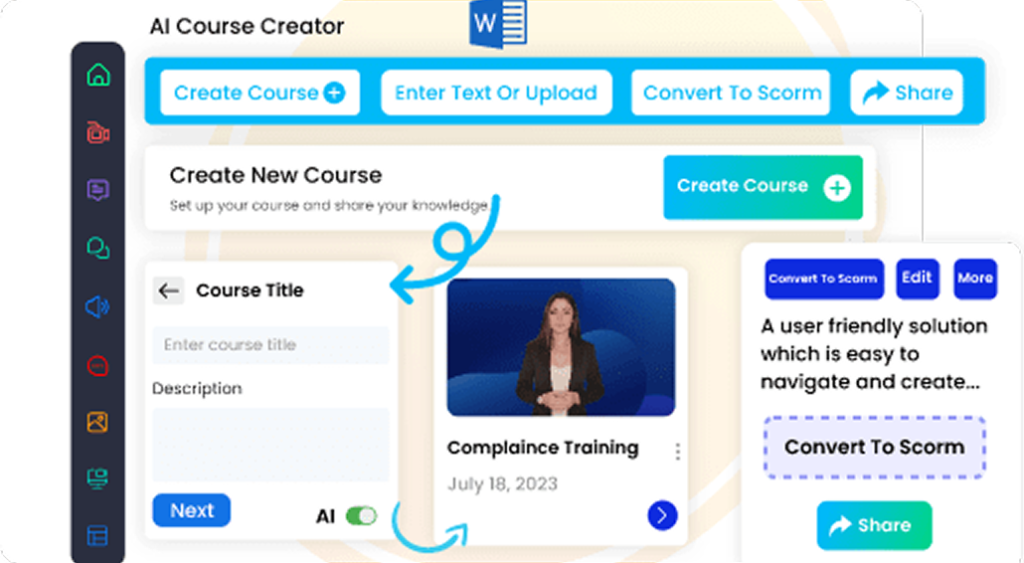In the evolving landscape of corporate learning, staying ahead of the curve means embracing tools that offer speed, flexibility, and personalization. Traditional training methods—often manual, time-intensive, and one-dimensional—are no longer sufficient to meet the needs of a diverse and fast-paced workforce. Enter AI-powered eLearning authoring tools: intelligent platforms that are transforming how companies develop, deliver, and manage training programs.
In this blog, we’ll explore how AI eLearning authoring tools are reshaping corporate training. From faster content development to personalized learning experiences, we’ll unpack the key benefits and answer some common questions about this game-changing technology.
Why Is Corporate Training Evolving?
Before diving into the impact of AI-Powered eLearning authoring tool, let’s understand why corporate training itself is undergoing a transformation. Modern organizations face a constant need to upskill employees, onboard new hires efficiently, and ensure consistent knowledge transfer across teams—often across locations and time zones.
However, traditional training methods are plagued by issues such as:
- Slow development cycles: Creating training content from scratch can take weeks or even months.
- One-size-fits-all learning: Standardized content often fails to address individual skill gaps.
- Low engagement: Static presentations and outdated formats rarely capture employees’ attention.
- Limited scalability: It’s difficult to roll out and maintain training programs across a growing or global workforce.
- Lack of readily available resources: Many organizations struggle with building or sourcing content quickly.
AI eLearning authoring tools provide a powerful solution to these challenges, enabling organizations to modernize training delivery and drive better outcomes.
How Do AI eLearning Authoring Tools Transform Corporate Training?
1. Rapid Course Creation With Automation
Use Case: A software company needs to roll out a new product training within a week. An AI tool can generate the course outline, populate content based on existing documentation, and insert interactive quizzes—cutting development time by over 60%.
2. Personalized Learning for Every Employee
Instead of forcing all employees through the same training path, AI tools create individualized learning experiences based on role, performance, and learning style. Adaptive algorithms can recommend content, modify difficulty levels, and identify areas where a learner might need extra help.
Example: A sales representative struggling with negotiation tactics might be guided to refresher content and simulations, while a high-performing team lead skips to advanced modules.
3. Interactive and Engaging Content
AI authoring platforms can integrate elements like gamification, microlearning, videos, and branching scenarios—making training more immersive. These features increase learner engagement, encourage participation, and improve knowledge retention.
Pro Tip: Tools that support multimedia integration and AI-generated simulations help employees practice real-world scenarios, boosting confidence and performance on the job.
4. Actionable Insights Through Real-Time Analytics
Built-in analytics features track learner progress, engagement levels, and content effectiveness. L&D professionals can identify which modules work well and which need improvement, enabling data-driven decisions.
Benefits: You get visibility into learner behavior, completion rates, and assessment performance—helping refine your training strategy for maximum impact.
5. Seamless Scaling Across Teams and Regions
Bonus: Some tools use AI translation to adapt content for different languages and cultural contexts without the need for external translation services.
6. Cost Efficiency Over Time
By automating repetitive tasks, minimizing development hours, and improving training outcomes, AI authoring tools offer long-term cost savings. Organizations can reuse and update content quickly—no need to recreate entire courses when policies or products change.
Explore: 24 Best eLearning Authoring tools
What Features Should You Look for in an AI Authoring Tool?
If you’re considering integrating AI into your corporate training strategy, here are some must-have features:
- Template-Based Design: Accelerate content creation with pre-built, customizable templates.
- Natural Language Processing (NLP): Transform plain text into structured, interactive course material automatically.
- Smart Assessments: Generate quizzes and evaluations based on course content and learner performance data.
- Real-Time Collaboration: Enable multiple team members and SMEs to work on content creation simultaneously.
- Cloud-Based Access: Allow users to access, edit, and deploy training content anytime, anywhere, on any device.
- Data Privacy and Security: Maintain compliance with internal policies and industry regulations.
- Multiple Language Support: Create and deliver training in various languages to accommodate a global workforce.
- PPT/PDF/MP4 to SCORM Conversion: Easily convert existing materials into SCORM-compliant formats for seamless LMS delivery.
- Seamless LMS Integration: Ensure your authoring tool integrates smoothly with your existing Learning Management System for efficient deployment, tracking, and reporting.
Empower Your Workforce With Smarter Training
AI eLearning authoring tools are more than just a technological upgrade—they’re a strategic advantage for any organization focused on growth, agility, and talent development. With faster content creation, enhanced engagement, and personalized learning paths, these tools are helping businesses stay ahead in a competitive landscape.
Ready to transform your corporate training?
Explore how AI-powered authoring tools can unlock better learning outcomes for your team.


























